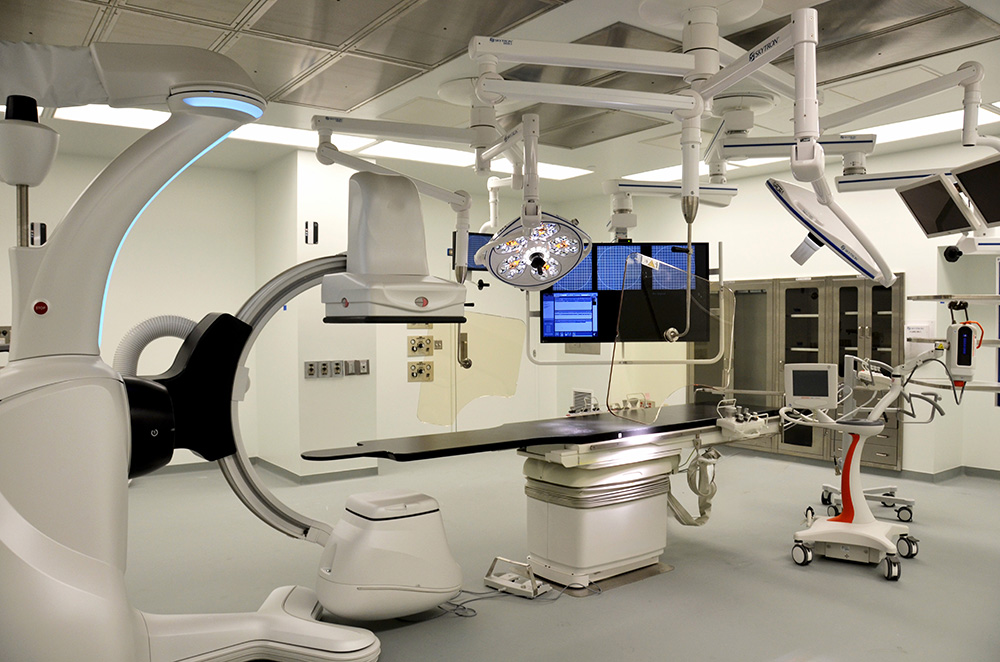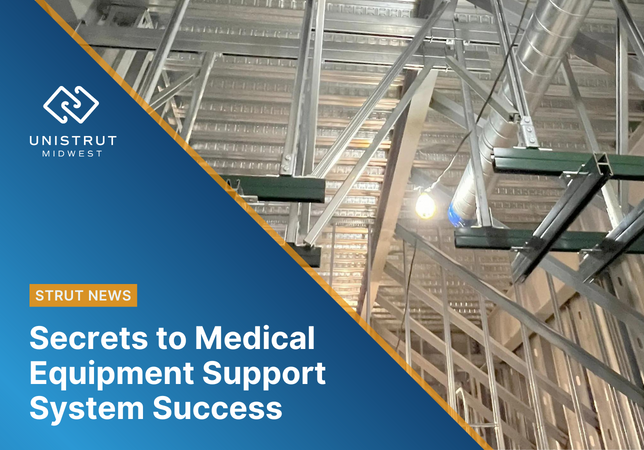Secrets to Medical Equipment Support System Success
September 3, 2024
While many think of patient care as bedside manner and medical diagnoses, at Unistrut Midwest we know that concern for the patient begins far before an exam starts or a hospital is even operating. Much of accurate and successful patient care relies on the critical machines and equipment overhead in a hospital or clinic. A reliable and effective support structure for that equipment is the first step towards providing exceptional healthcare. With such an important result on the line, even the smallest details of a build can become catastrophic if not properly implemented. Finding the right materials for your required supports and working with a partner who knows how to properly leverage those systems lays the framework for successful medical equipment supports.

How to Pick the Right Materials for your Medical Equipment Support Systems
An effective medical equipment system can support machinery that weighs thousands of pounds while still allowing that machinery to be nimbly placed throughout an operating or exam room. Because of the weight of this equipment, contractors have traditionally turned to welded structural steel for supports. While this solution does address the load requirements, it overlooks details that improve the experience of the healthcare providers and patients who will spend countless hours using the equipment.
Modular Support Systems vs Welded Steel
Building with welded structural steel is labor-intensive and doesn't easily allow for the precise adjustments required when constructing in a medical setting. From changes as basic as making room for new duct work to the delicate work of ensuring that x-ray equipment will be both level and easy to move, adjusting welded structural steel requires cutting, welding, and procuring new steel, driving up material and labor costs.
By leveraging a modular system like Unistrut or Sikla siFramo, both major and micro adjustments are achieved using only hand tools, often reusing existing materials. This allows installations to be quickly and easily adapted to specific site conditions, and facilitates straightforward adjustments for future structural changes. If a surgical light is upgraded to a newer model in the future, the modular support system can be easily adjusted to meet the new light's needs without the need for open flames, disruptive odors, or dangerous conditions in a functioning healthcare environment.
Fine Tuning the Specifics
While it can be tempting to choose the highest-duty support available, one benefit of Unistrut and Sikla systems is that they have low self-weight relative to their load capacity. This allows your system to be built with a lightweight material while still adequately supporting high moment loads.
For example, Unistrut Modular Support booms can handle moment loads of up to 20,000 lbs, but the standard UMS boom weighs less than 200 lbs. Their footprint is typically much smaller than traditional welded steel booms, leaving plenty of breathing room for additional systems. Picking the modular material that can support the highest load requirements while taking up minimal space is a skill that experienced partners hone in order to create highly efficient medical equipment support systems.
Additionally, Unistrut comes in a variety of finishes to meet the needs of a medical facility. As an experienced partner, Unistrut Midwest can help determine when to use standard finishes for cost savings and when to upgrade to specialty finish options.
How to Pick the Right Partner for your Medical Equipment Support Systems
Working with an inexperienced partner can result in an inefficient medical equipment support system that is behind schedule and over budget. Prioritizing a partner who understands how to create an efficient support system can lead to a more successful project.
Focus on the Details
There are specific criteria that are crucial to the success of a medical equipment system that are unlike other industries. Adhering to specifics like deflection and rotation criteria can make the difference between a properly calibrated machine and one that produces poor images. If those details are not considered in the initial support system design and installation and are only discovered upon final machine installation, it will require costly structural changes to fix.
Take plate rotation for example. Excessive plate rotation can cause a boom to drift, moving away from where the medical provider has placed it. In an operating room, that machine or light needs to be exactly where it was placed by the provider in order to ensure a smooth procedure. By designing the support structure to adhere to the rotation criteria, drifting machinery can be avoided. An experienced partner, like Unistrut Midwest, who understands and plans for these details is one to work with.
Avoid Overengineering
As discussed with selecting the right support materials, it can be easy to assume that a critical system like medical equipment supports need the biggest, heaviest, most supportive structures to be effective. But this thinking often leads to a support system that is over-designed and overpriced. Partnering with a team that has the experience to provide a proper design that meets project and equipment requirements without overengineering can be a huge help in keeping your project on budget.
Unistrut Midwest has decades of experience in engineering, designing, and installing medical equipment supports. As a full, turnkey solutions partner, we design systems, provide the materials, create P/E stamped drawings, prefabricate structures, and install supports on-site. By leveraging high-strength, modular Unistrut and Sikla siFramo systems, our team has created proven systems in healthcare facilities worldwide.

